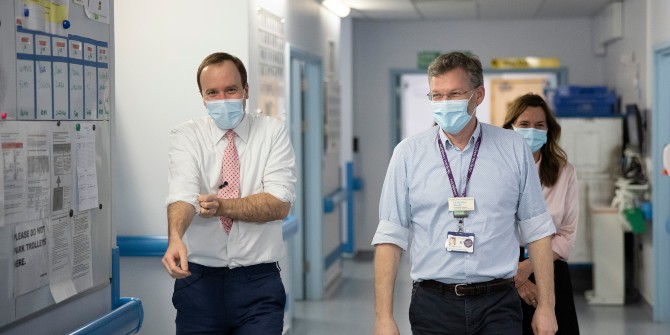Governments and businesses failed to prepare for a pandemic. It is vital they step up now to pre-empt the worst effects of the next one. Lucy Thompson (LSE) sets out three urgent priorities: better global co-ordination, health investment, and digital health services.
Lucy Thompson is responding to Alistair McGuire’s LSE Festival talk, What Can Health Services Learn from COVID-19? Join in the discussion below.
Hospitals are operating at or above full capacity, medical supplies are in high demand and health workers are exhausted, isolating, sick and dying themselves. More than a year since the start of the pandemic, health services in many parts of the world remain overstretched as they treat new waves and strains of the virus. As a result, the general population continues to face substantial barriers to care and diagnosis – whether for COVID-19 or for more common health conditions.
This pandemic has been catastrophic. But it also presents a brief window of opportunity to act. We could – and should – have been better prepared. COVID-19 was not a “black swan” event, or one that hit us completely unexpectedly and for which we could not have been prepared. It is, according to Nassim Nicholas Taleb, a “white swan”. This means that there is simply no excuse for the lack of preparation by governments and companies.
The question, then, is perhaps not what health services can learn from the pandemic, but what policymakers and businesses can do to foster more resilient health services in the future.
Priority 1: Co-ordinated governance
Doctors, virologists and data modelling experts have very important expertise to offer in crisis situations, but we also need to hear from those who understand a people-centred approach. Public health experts, health professionals and social workers, among others, can help form evidence-based policies that take into account the wider impact lockdowns and reduced public services will have on society.
Co-ordination is important enough within countries. At a global level, it is vital, and it has been lacking during the pandemic. Early on, many countries moved against WHO recommendations in order to impose travel restrictions to stop the spread of COVID. Evidence suggests that travel restrictions may slow the spread of a disease, but do not prevent it, and restrictions proved damaging to the global economy and people’s wellbeing. They also significantly disrupted the delivery of equipment needed for personal protection of health workers, ventilators and other intensive care unit equipment.
At the time of writing there have been 110 million cases and close to 2.5 million deaths worldwide. These numbers will continue to rise until the virus is eradicated through global immunisation, or rendered innocuous through effective prevention and treatment programmes. Vaccination programmes are now well underway in some richer countries, but more than 85 low- and middle-income countries will not have widespread access to the vaccine until 2023. Global health governance must bring together governments and manufacturers to protect access to vital supplies like food, medicine and vaccines for all – whoever they are and wherever they live.
Priority 2: Health investment
Tight restrictions on movement to curb the disease caused obvious economic damage, the extent of which is still not completely clear. People on low incomes have paid the highest price. In the UK during the first national lockdown, top-earning workers were on average 50% more likely to work from home than low earners. At the same time, low-income workers were twice as likely to have to stop working completely, compared to their higher-income peers.
Public support has been unprecedented in scale and scope, funded primarily by public borrowing. The Institute for Government estimates that announcements made by the government up to mid-September 2020 imply that the cost of COVID-19 to the UK government – in the form of increased public borrowing – will be £317.4 billion in 2020/21 alone. Yet years of declining and inadequate capital spending for the NHS in England meant that public health infrastructure was ill-equipped to deal with the crisis.

Diseases present us with obvious health costs, but there are significant economic costs to illness too. Investing more in health systems and disease prevention, including the use of modern technologies and diagnostics, would not only allow us to cope with future health challenges, but possibly reduce the cost of ongoing healthcare. For example, obesity is a key risk factor for poor COVID-19 outcomes. In September, the UK government reacted to this by unveiling a new obesity strategy, urging the population to lose weight to beat COVID-19 and protect the NHS. Had greater funding been made available for this at an earlier stage, the human, social and economic cost of the virus might have been less.
Priority 3: Embrace digital
COVID-19 has forced companies to transform the way goods are traded and services provided. This is also true in the health sector. A recent US study found that use of in-person medical services dropped by 23% in March 2020 and 52% the following month, with telemedicine services growing by more than 1000% and then 4000%. Telemedicine reduces transportation time and costs, gives easy access to specialists and reduces the chances of catching something in a surgery waiting room. Remote testing has also become a major new player. Home swab kits are available to diagnose COVID-19, and the UK government is now extending this to further preventative tests like cervical smears. Just as people have turned to remote working and online banking, they are now likely to be more receptive to online health services.
Critically, these changes cannot be the work of health service providers alone. They must be underpinned by policy decisions that recognise the full human, social and economic cost of disease and the value of health to society. Our hope is that, through projects like the Partnership on Health System Sustainability and Resilience, policymakers can engage with researchers and businesses both in Britain and abroad to enable these changes to be implemented.
This post represents the views of the author and not those of the COVID-19 blog, nor LSE.





